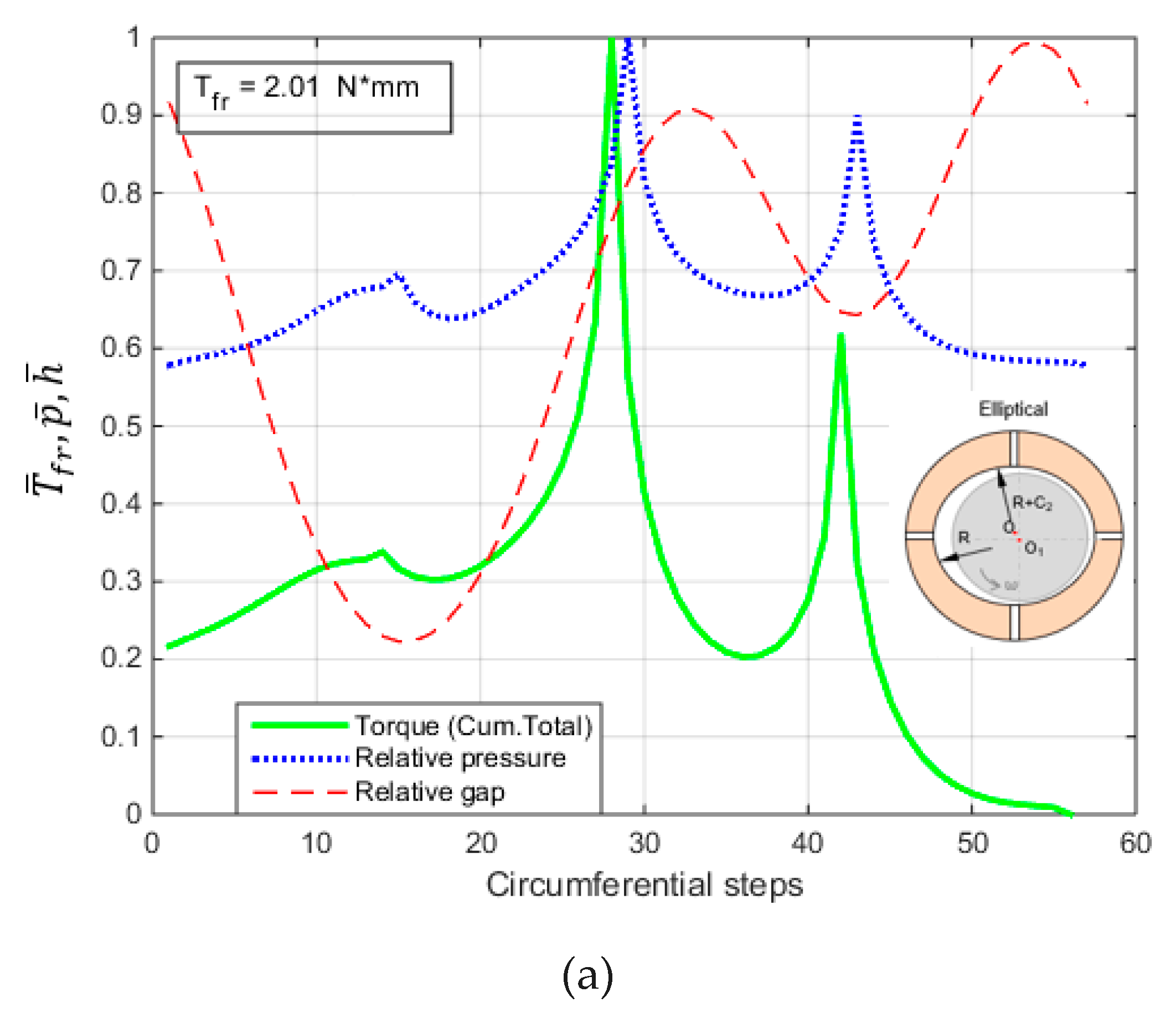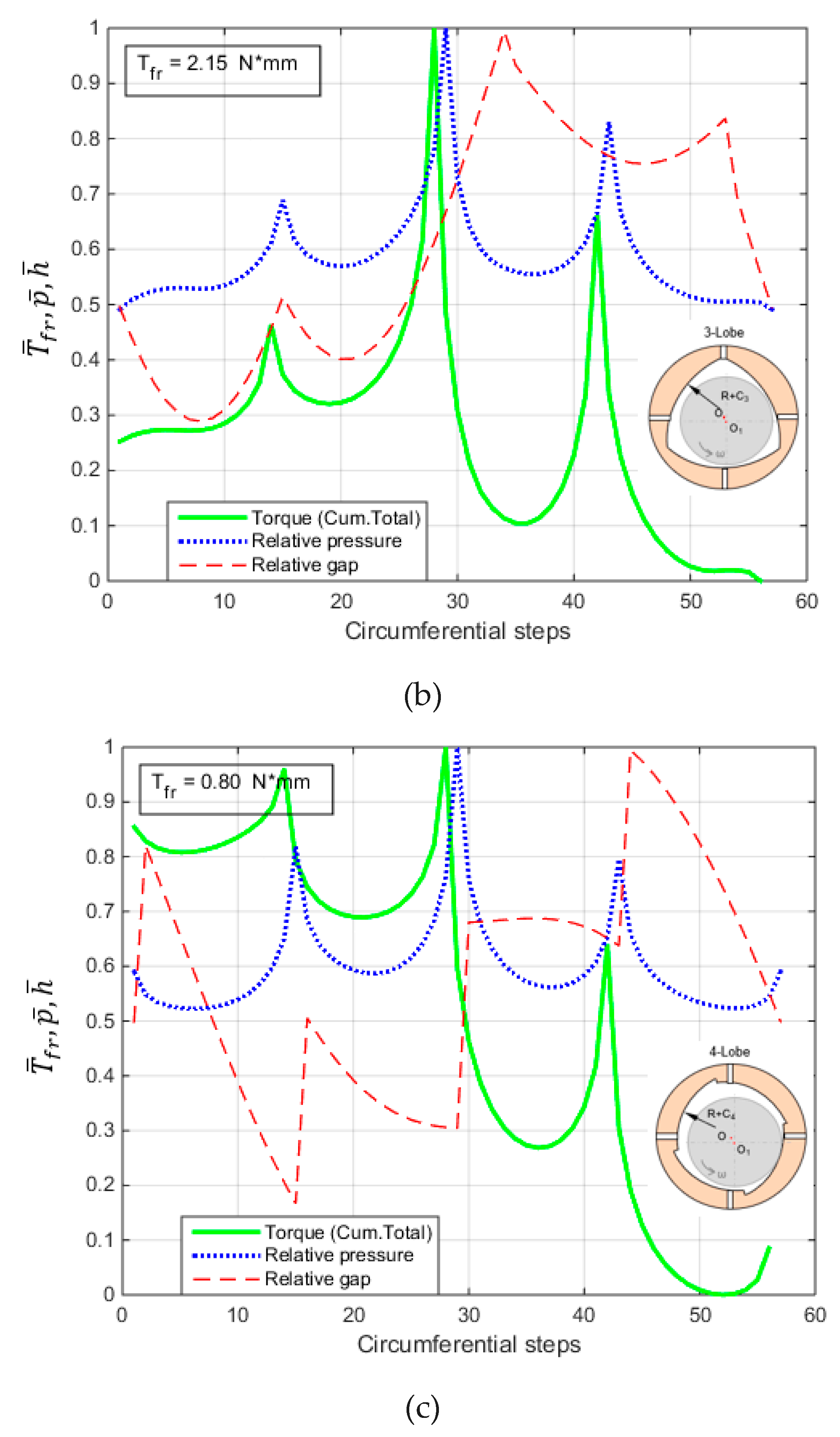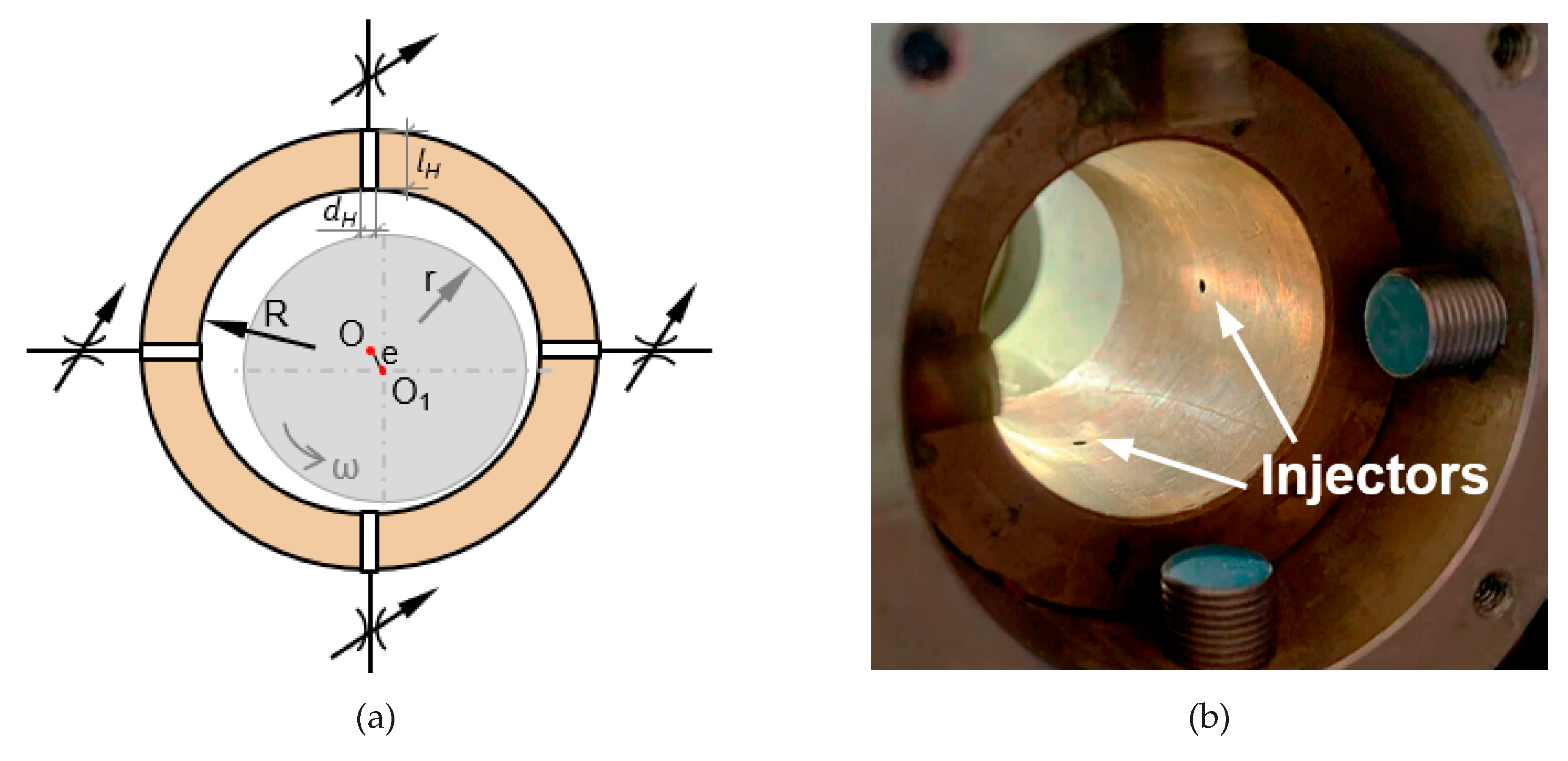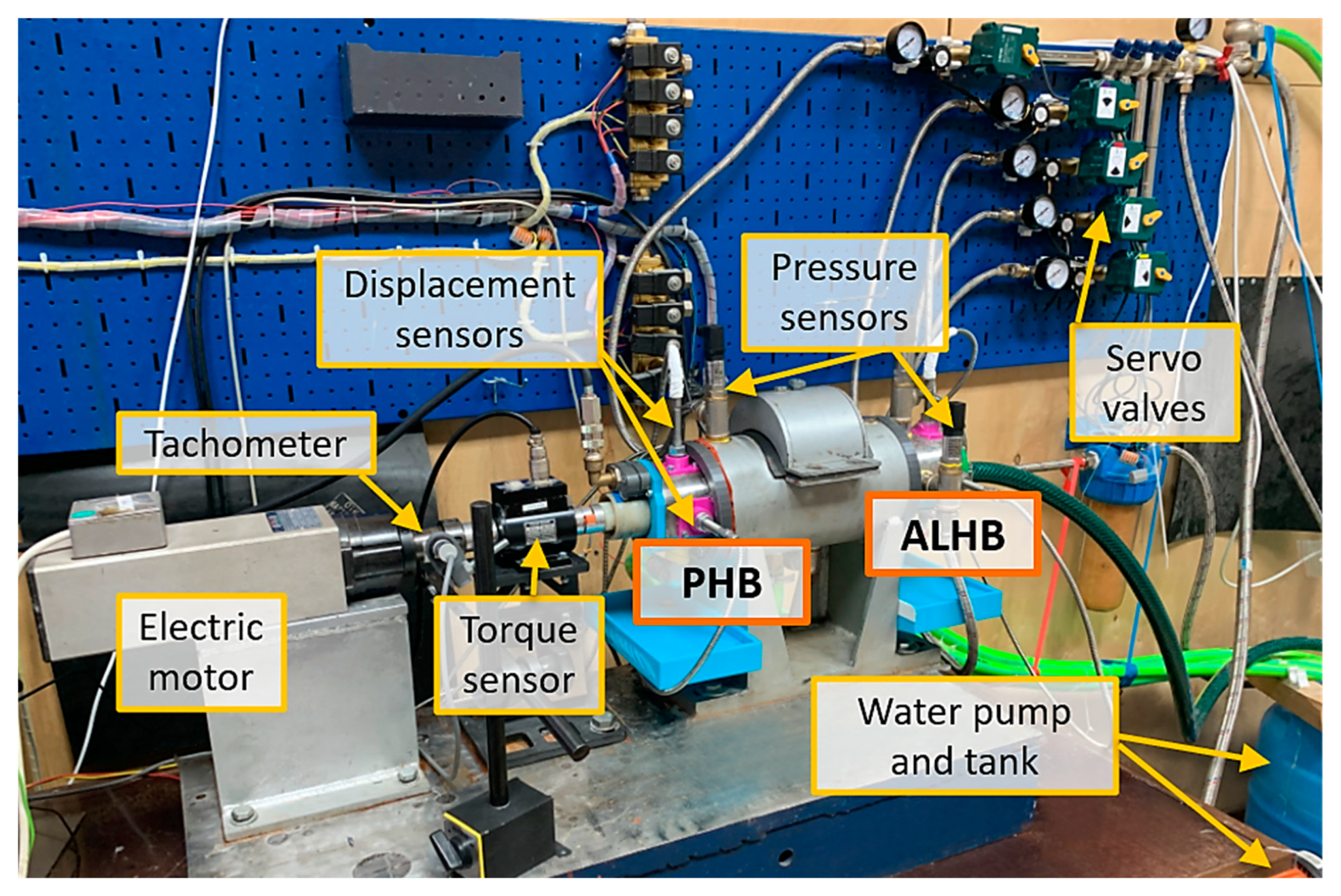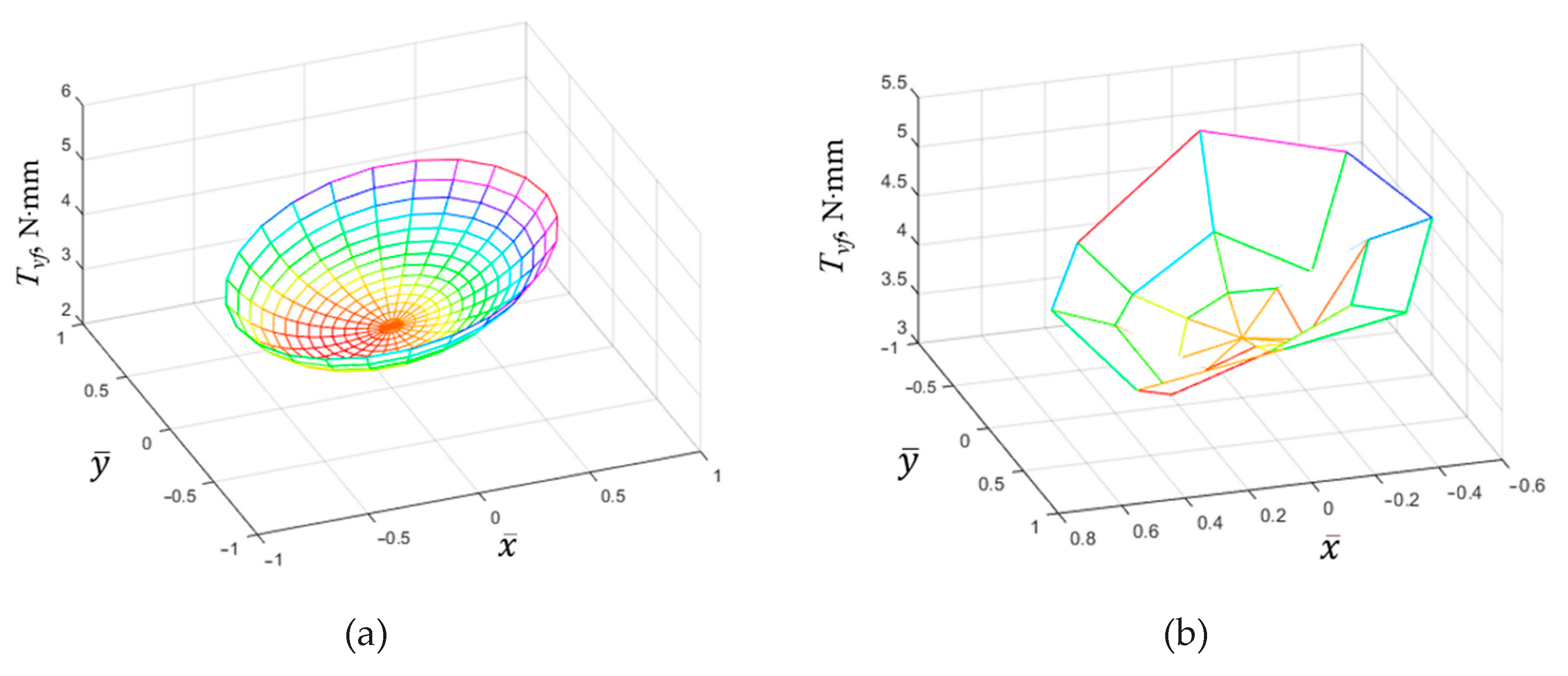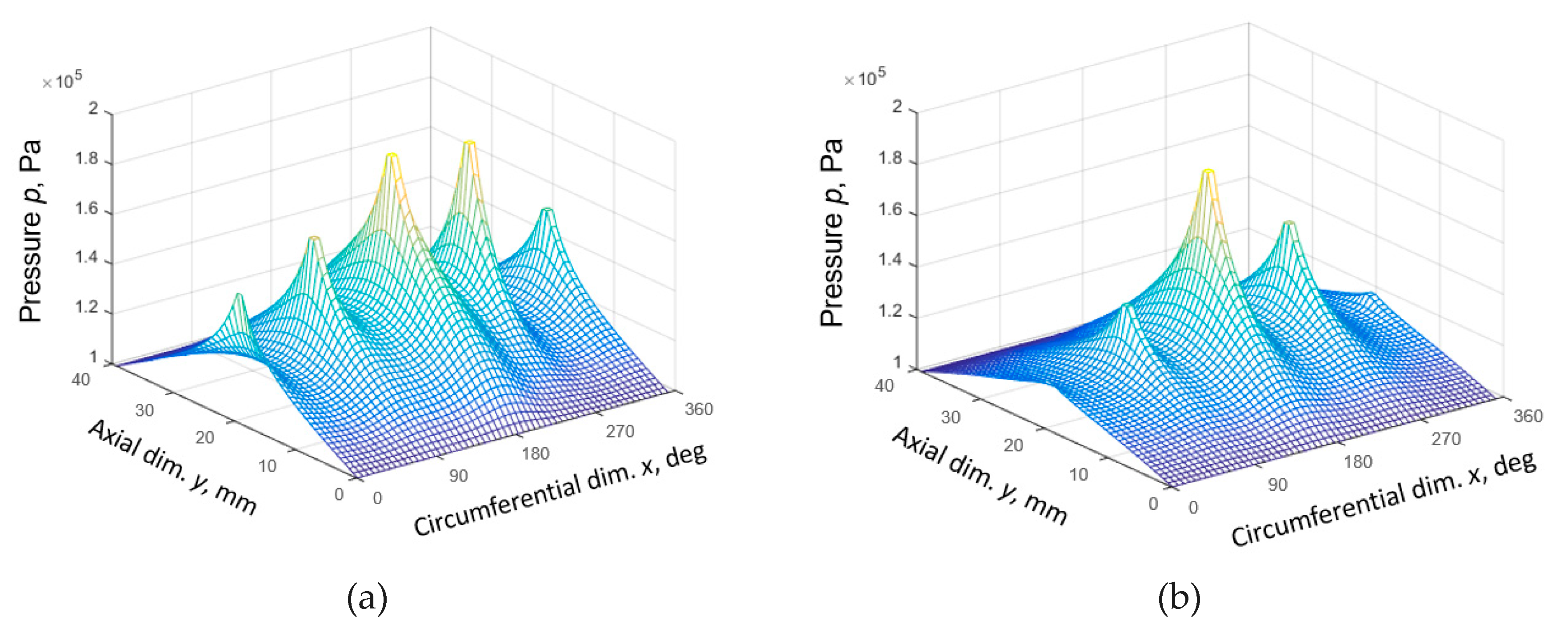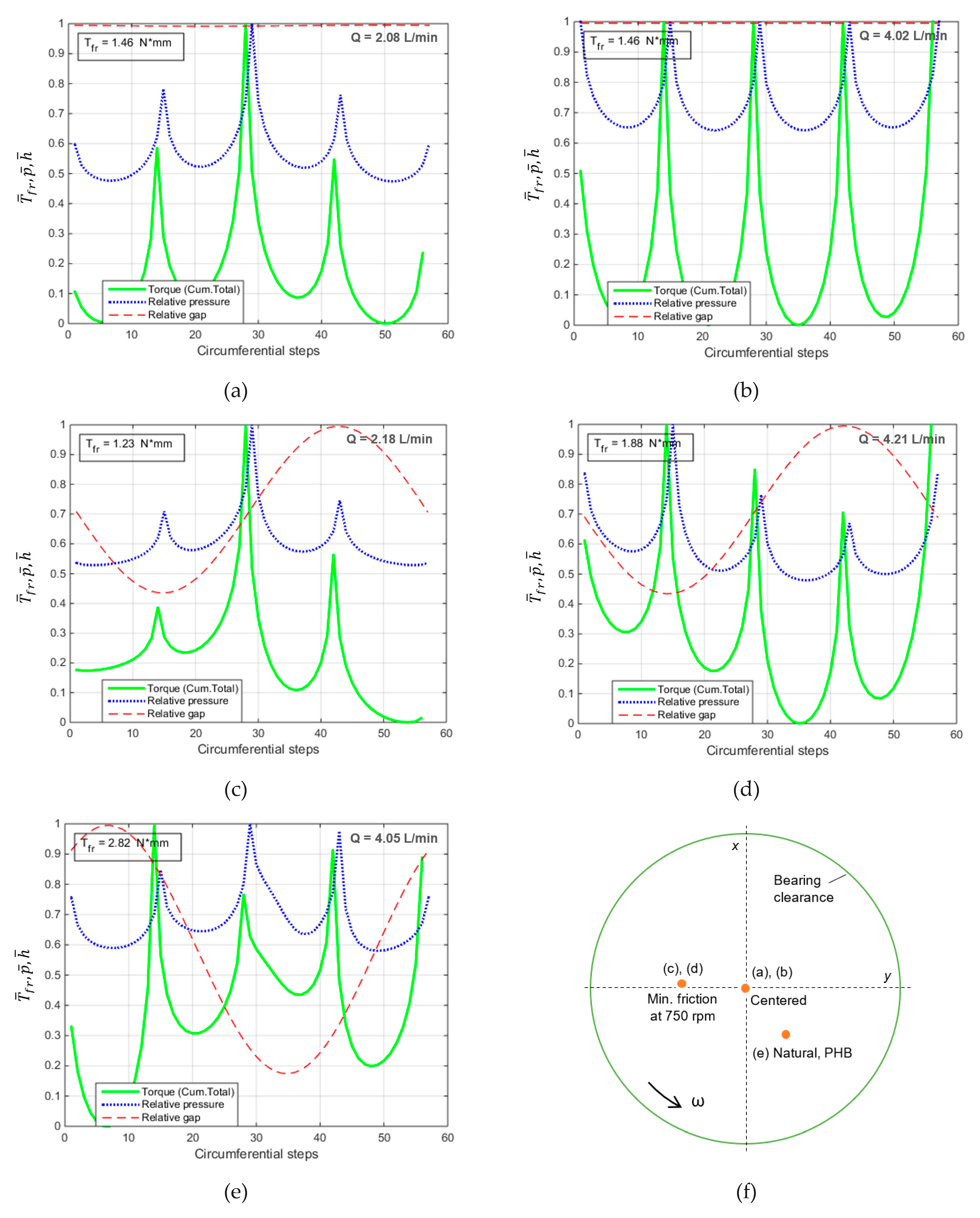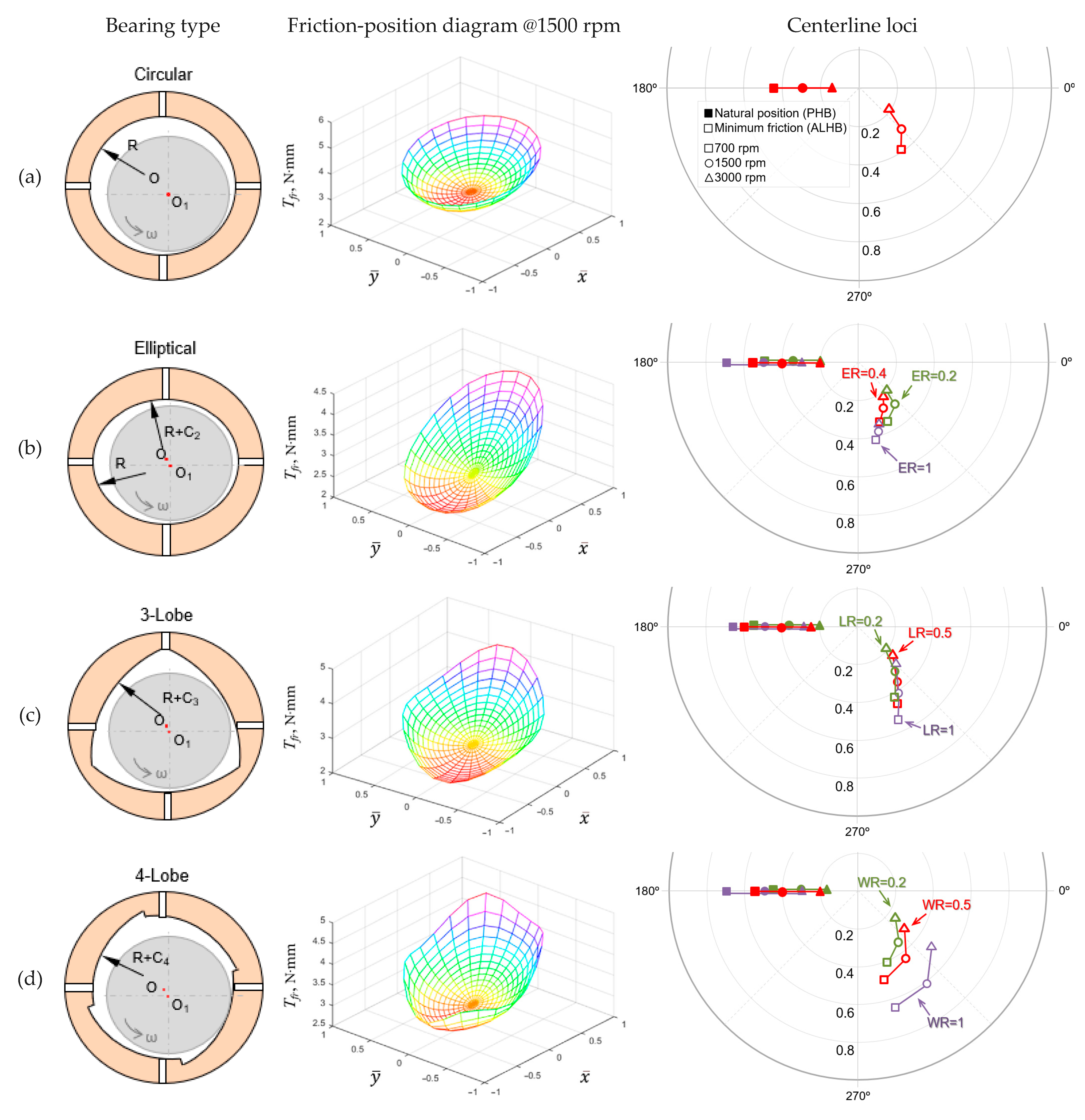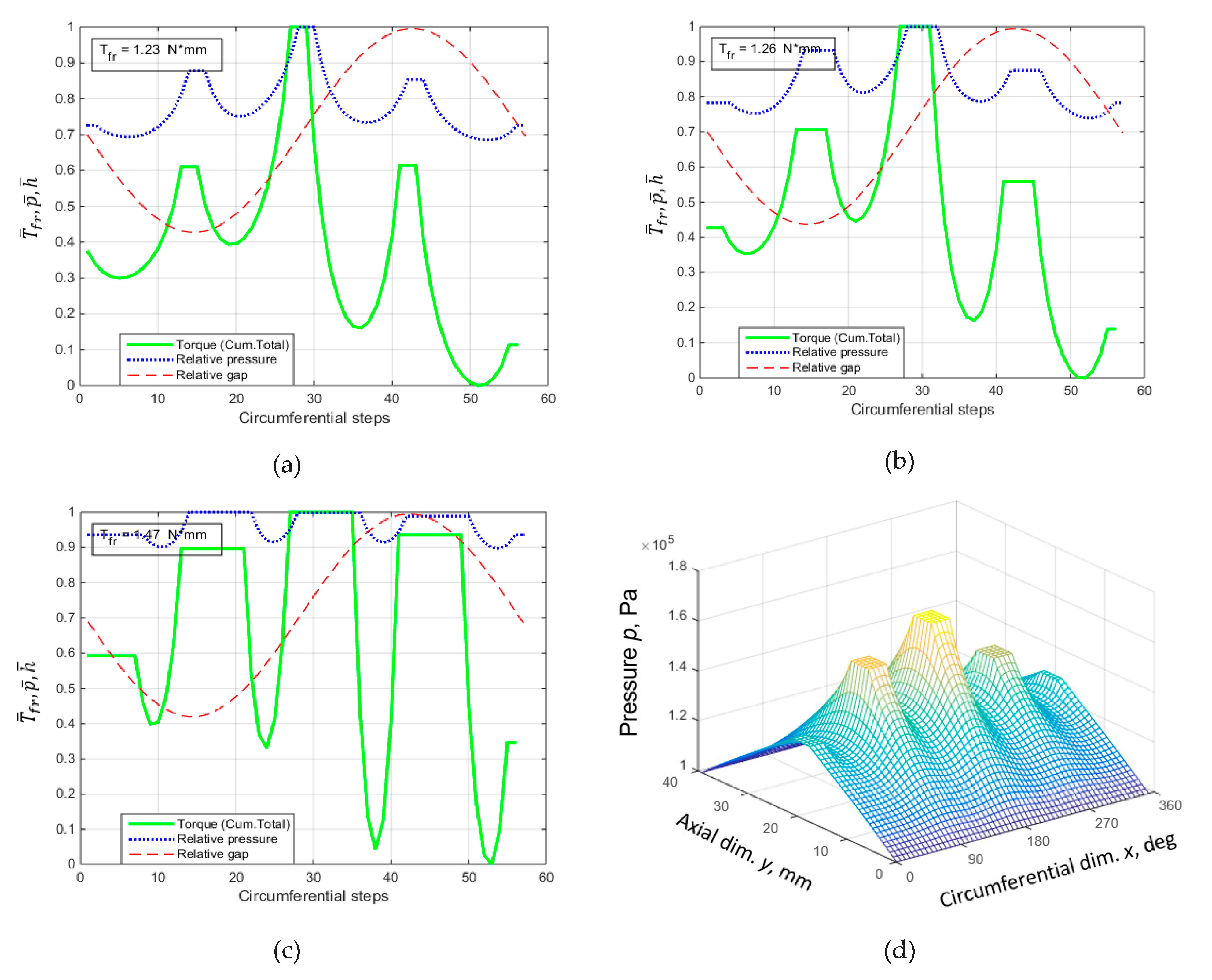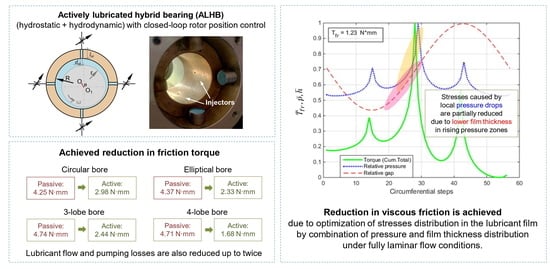3.1. Theoretical Substantiation of the Minimum of Fluid Friction in Journal Fluid Film Bearings
The main equation for calculation of the torque created by the viscous friction forces in the lubricant film of a journal bearing is as follows:
Equation (6) is derived using Newton’s equation of viscosity [
28,
29] and describes the viscous friction torque caused by the viscous stresses in the thin film lubricant flow within the bearing gap with a rotating shaft. As noted in
Section 2.1, the lubricant flow under the given conditions is considered laminar, so the influence of turbulence is excluded from consideration. The first component of (6)
shows the contribution of the stresses caused pressure drops within the fluid film, while the second part
describes the contribution of the stresses caused by the partial entrainment of the lubricant film by the shaft surface moving along the bearing walls. The resulting viscous friction torque
Tvf resists the shaft rotation in the bearing at the considered conditions.
The active lubrication system in the ALHB affects both directly the pressure distribution and, indirectly, the rotor position. The rotor displacements lead to a change in the gap function h and, as a result, to a change in the hydrodynamic pressure distribution, which is described by Reynolds Equation (1).
An analysis of the conditions providing minimization of the viscous friction forces (6) in fluid film bearings will be presented below.
3.1.1. Plain Hydrodynamic Bearings
A plain hydrodynamic bearing is the basic system for a hybrid bearing. The active lubrication system can be considered a superstructure that influences the pressure distribution in the fluid film and the rotor position in the bearing.
If the shaft takes a steady position in the hydrodynamic bearing, then according to Equation (6) and under the assumptions made, the pressure distribution depends on the lubricant viscosity
µ, the shaft rotation speed
U and its position in bearing
h. The first two parameters are considered constant since they are set by the design and operating conditions of the machine. The shaft position in the bearing is described by the gap function (4). Thus, the equilibrium position of the shaft
heq =
f(
U,
µ,
h0) is one of the design characteristics of a plain bearing along with the minimum film thickness,
hmin ≡
heq. In this case, the condition for the minimum of
Tvf can be formulated if the parameter
h is considered variable. The shaft can change position relative to the equilibrium in a plain bearing under disturbing and/or control forces, for example, as in [
30]. In this case, the right part of Equation (6)
will be a constant for given
U and
µ at a constant bearing clearance geometry:
Thus, the condition for minimizing
Tvf can be formulated as
The ultimate case of condition (8) is the uniform pressure distribution in the entire bearing. Taking into account Equation (7), in a circular plain bearing, this is ensured by the centered position of the rotating shaft when the film thickness is constant over the entire circumference, h = h0. With that, in non-circular bearings, the centered shaft position is not associated with constant clearance.
In the general case, the most centered position of the rotor can be called the condition for minimizing viscous friction in a plain hydrodynamic bearing. In practice, this configuration is of little use since the bearing forces and the load capacity are minimal with a centered shaft position. The close-to-center shaft position can be achieved either at high rotational speeds and/or lubricant viscosity, as an instantaneous (non-equilibrium) position, or under external control, as in [
30]. In this case, the rotor motion may be unstable in the absence of restraining forces, and the bearing turns into a damper or a safety device in the machine.
3.1.2. Hydrostatic and Hybrid Bearings
Unlike a hydrodynamic bearing, hydrostatic, and hybrid (combination of hydrostatic and hydrodynamic) bearings, the hydrostatic forces provide a stabilizing effect even with the centered shaft. Four lubricant supply channels create four pressure peaks evenly distributed around the circumference in the considered hybrid bearing design, as shown in
Figure 4. Injectors create local zones with modified pressure regulated with the control system and servo valves. The pressure ratio and throttling effect determine the equilibrium position of a balanced rotor in the bearing.
A change in the pressure and film thickness distribution compared to a plain bearing also provides a change in the distribution of shear stresses in the fluid film and hence the viscous friction torque. In particular,
Figure 4a shows the pressure distribution in a conventional passive hybrid bearing (PHB), and
Figure 4b shows the pressure distribution in an ALHB holding the shaft in the minimum friction according to [
18]. This effect will be analyzed in more detail below.
The contribution of the right part of (1) to the total viscous friction in a hybrid bearing remains the same as for a hydrodynamic bearing. On the contrary, due to the presence of multiple pressure drop zones in the central region of the hybrid bearing, the structure of the shear stresses resulting in viscous friction differs from plain bearing. The differences are primarily provided by the left side of (1) . A number of states of a rotary system with the hybrid bearing were calculated to evaluate its tribological behavior:
- (1)
centered equilibrium shaft position, provided by operation of the ALHB control system;
- (2)
centered non-equilibrium shaft position in the PHB;
- (3)
equilibrium shaft position with minimal friction, provided by the operation of the ALHB control system, as in the case in
Figure 4b;
- (4)
non-equilibrium shaft position at the same point as in the previous case (item 3), but in the PHB;
- (5)
equilibrium natural shaft position in the PHB, as in the case in
Figure 4a.
The calculation results are presented in
Figure 5 in the corresponding order, adding the diagram illustrating the shaft positions in the bearing for these cases. The rotation speed of a perfectly balanced rotor in all cases was 750 rpm. With it, the contribution of the hydrodynamic effect to the bearing pressure distribution is relatively small, and the effect of the hydrostatic component can be considered in a more isolated manner.
The pressure and film thickness distributions in
Figure 5 are presented in a dimensionless form, respectively,
and
. Pressure distribution
p = pcl is given for the central cross-section of the bearing passing through the centers of the injectors. This distribution characterizes the tribological state of the bearing quite fully due to its symmetry and the absence of misalignments. The friction torque
Tvf is presented as the cumulative total of the integral in (1) for the same pressure distribution
pcl at the bearing center line. The resulting graph shows, in fact, the change in the integral sum of the moments of shear-pressure stresses in the central zone of the bearing when integration in the direction of the bearing
z-axis is excluded from (1):
A joint analysis of the
graphs in
Figure 5 with Equation (9) clarifies the contribution of shear-pressure stresses in different zones of the fluid film in the circumferential direction to the total viscous friction
Tvf for the various system states.
Figure 5a,b demonstrates that, like in a plain bearing, the resulting friction decreases at the centered shaft position in comparison with its natural position,
Figure 5e. Indeed, in this case:
because in a circular bearing
h = h0 = const. Additionally, since the pressure distribution is closed in the circumferential direction, and considering the assumptions made:
However, for any non-centered shaft positions in a circular bearing
h ≠ const. The changing film thickness corrects Equation (10) so that:
Indeed,
Figure 5a,b represent the centered shaft position. In the (b) case, it is a non-equilibrium state, while in the (a) case, it is equilibrium provided by an active lubrication system, which affects the pressure distribution. Since the film thickness is constant in the whole bearing gap, a change in the pressure distribution does not lead to a change in the friction torque. The stresses in the fluid film caused by the pressure gradient cancel each other out. The friction torque value
Tvf = 1.46 N∙mm in this case, calculated numerically according to (1), is equal to the minimum possible torque for a plain hydrodynamic bearing, provided only by the shear stresses in the Couette flow.
Further analysis of
Figure 5 shows that for some system states, the combination of clearance and pressure functions is such that the total viscous friction torque can become even smaller than in the case of the mentioned centered shaft position.
Figure 5c,d shows the states with the shaft at the calculated friction minimum position at 750 rpm. In case (c), like in case (b), the system state is equilibrium, provided by an active lubrication system, and in case (d), it is non-equilibrium, for the case of the PHB. While the film thickness distribution is equal in cases (c) and (d), the difference is in the pressure distribution. In case (c), in the ALHB, the largest pressure changes occur in the divergent part of the bearing gap. The zone of the greatest increase in pressure falls on the region with a smaller gap than the almost symmetrical zone of the greatest pressure fall. The stresses caused by the pressure gradient in the area of increasing pressure around the injector make a smaller contribution to the total viscous friction torque due to the thinner fluid film. In
Figure 5c, this can be seen in the drop in the
value after this region in comparison to the (d) case in the PHB, where such a drop is not observed due to a more uniform pressure distribution. As a result, the total friction torque in the PHB is 1.88 N∙mm, which is 29% greater than at the centered shaft position and 53% greater than at the same shaft position in the ALHB.
Another effect seen in
Figure 5 is the reduction in lubricant flow through the bearing when the shaft is in the minimum friction or centered position. For the considered case, the water flow rate changes approximately two times, from 4 to 2 L/min. This is primarily due to a change in the lubricant pressure in the supply channels and its relationship with local hydraulic resistances in the bearing gap near the injectors. In particular, to raise the rotor above the initial “natural” position, the control system increases the pressure in the lower channel and lowers it in the opposite upper one. The supply pressure to the channels along the X-axis partially changes. Further, due to the displacement of the shaft in the bearing, the clearance decreases, and the local hydraulic resistance increases in the area of those injectors through which the greatest consumption of lubricant occurs in the PHB. As a result, the total lubricant consumption is reduced, and hence the required power for its pumping, which will be further discussed below.
The shear stresses in the fluid film caused by the shaft rotation at the minimum friction position in the ALHB are partially offset by the stresses caused by the pressure gradient. Thus, the total viscous friction torque in the ALHB is lower than the theoretical minimum in a similar hydrodynamic plain and in a PHB. In addition, the theoretical minimum of friction is practically unattainable in plain hydrodynamic bearings due to the minimization of the load capacity at the centered shaft position of the rotor. At the same time, an ALHB is able to provide an equilibrium shaft position at the theoretical minimum friction region and maintain this state for the required time.
Another effect seen in
Figure 5 is the reduction in the lubricant flow through the bearing when the shaft is at the minimum friction position or at the centered position. The water flow rate is approximately halved, from 4 to 2 L/min for the considered case. This is primarily due to the controllable change in the lubricant pressure in the supply channels and its relationship with local hydraulic resistances in the bearing gap near the injectors. In particular, the ALHB control system increases the pressure in the lower channel and decreases it in the opposite upper one in order to move the shaft above the initial natural position, typical for a PHB. The supply pressures to the channels along the X-axis are also partially adjusted. Due to the shaft displacement, the clearance decreases, and the local hydraulic resistance increases near the injectors that provide the greatest lubricant flow in the PHB. As a result, the total lubricant flow, and hence the power required for pumping it, is reduced, which will be further discussed below.
3.2. Minimization of Viscous Friction in Non-Circular ALHB
The conclusions of
Section 3.1 are related primarily to circular fluid film bearings. The eccentric shaft position in them is characterized by the presence of only convergent and divergent regions. However, in practice, non-circular bearings with various types of bores are used. They improve the stability of the rotor motion with a certain decrease in load capacity and an increase in viscous friction [
31]. With a non-circular profile, two or more convergent and divergent areas may appear in the bearing. The implementation of the active lubrication principle in them makes it possible to obtain more diverse ratios of pressure and film thickness than in circular bearings. This gives more opportunities for further optimization of the viscous friction parameters.
A number of friction-versus-shaft-position diagrams were obtained for actively lubricated elliptical, 3- and 4-lobe bearings. As in circular bearings, the active lubrication is implemented in them with four evenly spaced injectors. Although different local hydraulic resistances are possible for different injectors in non-circular bearings, the simulation shows that this has little effect on the quality of rotor position control. Adopting the control techniques to the gap shape is not quite necessary, although it could be one of the possible directions for optimizing active rotor-bearing systems.
Figure 6 shows the calculation results for the considered non-circular bearings. The elliptical bore is characterized by the parameter ER =
C2/h0, the 3-lobe by LR =
C3/h0, and the 4-lobe by WR =
C4/h0. The
C2,
C3, and
C4 values are the offsets of the boring radii relative to the radius of the circular bearing
R. For a more complete analysis, several versions of each non-circular bearing with more and less pronounced geometric changes were additionally tested. The simulation was performed for three rotation speeds of 750, 1500, and 3000 rpm. The minimum speed of 750 rpm is set to be high enough to provide the rotor lift-off in the water-lubricated hydrodynamic bearing. The maximum speed of 3000 rpm was chosen because, under the conditions considered, the minimum friction position at this speed was situated quite close to the bearing center.
A summary of the friction parameters and minimum film thickness of the tested bearings is presented in
Table 2. It shows the results for the rotation speed of 1500 rpm, as this is the most representative mode. Data for other speeds are presented in
Appendix A,
Table A1 and
Table A2.
Figure 6 shows that the diagrams of the dependence of friction on the shaft position in the ALHB have the same pronounced friction minima for all considered types of non-circular bearings as for circular ones. In addition, one can note their characteristic shape with local zones of increased friction at higher eccentricities. The number of such zones coincides with the number of constituent elements of the bearing profile. This is due to a local decrease in the gap when the rotor in the ALHB is positioned near the protruding profile elements. In all cases, the position with minimum friction is located near the
x-axis and tends to move towards the bearing center with increasing rotation speed. In all cases, the minimum friction points for speeds of 750, 1500, and 3000 rpm are farther apart for non-circular bearings and also for more pronounced non-circularity.
The calculations show, as expected, that the load capacity of the bearings with a more pronounced non-circular profile tends to decrease. This is manifested in a decrease in the minimum film thickness hmin. The viscous friction torque at the natural shaft position in the PHB also tends to be higher than in a circular bearing due to the increase in pressure gradient zones.
As in circular bearings, the implementation of rotor position control using active lubrication in non-circular cases allows the reduction of viscous friction relative to the corresponding PHBs. At the same time, non-circular bearings demonstrate the ability to achieve an even greater reduction in friction. Thus, according to the data in
Table 2, a reduction in viscous friction of up to 30% was achieved for the circular bearing. For non-circular ones with comparable initial friction, the active lubrication reduced it by up to 47% for elliptical (ER = 0.4), 49% for 3-lobe (LR = 0.5), and 74% for 4-lobe (WR = 0.5) bores. At the same time, if the friction in the PHB increases for more pronounced non-circularities, the ability of ALHB to reduce it increases in such cases. Therefore, the greatest achieved reduction in friction was 53% for elliptical and 3-lobe bearings and 83% for the 4-lobe design. The latter result thus shows a friction reduction of almost six times compared to the PHB. This result stands out against the background of other bearings and, possibly, can be associated with simplifications in modeling the geometry of fixed wedges, for example, in the omission of the rounding of their trailing edges. However, despite the possible computational inaccuracies, the result is consistent with the general trend when the non-circular bearings provide additional opportunities in optimizing the tribological state behavior when using active lubrication.
In addition, a number of diagrams similar to those shown in
Figure 5 were calculated for non-circular bearings to further illustrate the phenomena. The diagrams are presented in
Appendix B and show data for each of the considered types of bearings at 1500 rpm in the configurations that provide the greatest reduction in friction.
3.3. Discussion
The obtained results demonstrate how active lubrication in hybrid fluid film bearings can not only improve the parameters of rotor motion but also optimize their tribological behavior. It allows the rotor-bearing system to achieve such states that the resulting viscous friction torque can become significantly lower than its minimum possible value for similar plain bearings without external pressurizing. The key factor for this is the relation between the film thickness and pressure distributions that determine the stresses caused by the pressure gradient in the lubricant film. The viscous friction forces in the bearing can be reduced by optimizing the stress distribution through active lubrication. This technique allows influencing the pressure distribution both in direct and indirect ways through adjusting the lubricant pressure in supply channels and the shaft position, correspondingly. As a result, more variations of film thickness and pressure distributions can be obtained in the ALHB compared to the passive plain bearing and PHB.
In the general case, the minimization of viscous friction, in this case, is provided by the coincidence of the zones of the largest pressure drops with the divergent area or areas of the fluid film. Using this provision as a criterion during calculations provides more opportunities for optimizing the tribological behavior of various fluid film bearings. Being based on fundamental physical principles, this approach is likely to be applicable not only to actively lubricated bearings but also to active bearings utilizing other control principles, an overview of which is given, for example, in [
32]. However, a detailed analysis of the possibility of reducing viscous friction due to the considered approach is required for each new control scheme.
It should be noted here that this work provides a basic theoretical justification for the considered effect and characterizes the main possibilities of the approach to reducing viscous friction. It is based on a number of mentioned simplifications and assumptions that should be taken into account when evaluating the results for practical implementation. Numerous studies show that such factors as rotor misalignment, turbulence, and multi-phase flows in the fluid film can have a significant impact on the bearing characteristics. In particular, they can significantly modify the pressure distribution and even the continuity of the lubricant film, especially in the divergent part of the bearing gap, which can significantly affect the considered phenomena of reducing viscous friction. On the other hand, the externally pressurized lubricant supply to the appropriate areas of the fluid film can possibly reduce the likelihood of the effects associated with its discontinuities. The influence of these factors on the implementation of the described principle of reducing viscous friction requires additional studies, also taking into account the design features and the operating modes of certain rotor-bearing systems.
The influence of turbulence in this issue is particularly important in the context of this study. The transition from fully laminar to turbulent lubricant flow in the bearing, including the initial occurrence of Taylor vortices with an increasing Reynolds number, increases the resistance of the fluid film to the rotation of the shaft [
21]. These phenomena qualitatively change the tribological behavior of the rotor-bearing system and limit the applicability of the presented results to purely laminar operating modes of bearings. The issue of the influence of Taylor vortices and fully turbulent lubricant flow on the implementation of the considered approach requires additional research, including extending the mathematical and numerical simulation models. Additionally, while considering implementing the described approach in a certain application, other factors that bring the transition to turbulent regimes closer should be considered, such as thermal effects.
Further, a bearing with a relatively high
h0/R ratio of 0.005 was simulated during the numerical procedures because it corresponds to the actual parameters of the experimental bearing considered in [
19]. At the same time, the scope of this work includes only the phenomena in thin lubricant films, which are usually considered in the study of conventional fluid film bearings. In such films, the inertia forces in the lubricant flow are small compared to the viscous forces, and Reynolds Equation (1) is applicable. Since the considered ratio
h0/R ratio of 0.005 puts the considered system relatively close to the corresponding limits, additional numerical tests were carried out to verify the validity of the obtained results for more conventional journal bearings. The tests have shown that for circular bearings with thinner films, the ratios of tribological parameters remain the same, as shown in this paper. In particular, in a circular ALHB with
h0/R = 0.002 at 1500 rpm, the maximum reduction in friction relative to the same PHB at the same Sommerfeld number is 29% (from 10.80 to 7.68 N·mm), which coincides with the data in
Table 2 for the tested bearing with
h0/R = 0.005. Thus, in accordance with the principle of similarity, the results shown and the conclusions made can be considered valid for bearings in which inertia forces in the fluid film can be neglected according to their design and operation parameters [
33].
Another interesting conclusion is that the reduction of viscous friction in the fluid film of hybrid bearings is not the only benefit of the implementation of the considered approach in terms of reducing energy costs. As the results show, a reduction in lubricant flow can lead to even more effect in energy saving in absolute terms than the reduction in the bearing friction torque. For the results in
Figure 5, the viscous friction torque was reduced a maximum of 2.3 times in the ALHB compared to the PHB, and the lubricant flow was also reduced almost two times. The power losses for overcoming the viscous friction
Nvf and for lubricant pumping through the bearing
Np are:
In absolute terms, the corresponding power losses in the considered case were reduced from 2.2 to 1 W for Nvf, and from 27 to 14.5 W for Np in a single bearing. So, the expected energy savings due to the reduction in the lubricant flow is 10 times more than due to the reduction in the viscous friction. With that, the last can also provide some indirect additional advantages, like improvement in the dynamic rotor behavior under reduced friction, the possibility of refusing from the lubricant cooling facilities, etc. It also should be noted that the power losses in the lubricant supply pipelines are not considered, excluding the impedance in the bearing’s injectors required for the calculation of the hydrostatic effect. Such power losses depend on a specific configuration of the supply system and usually are subject to optimization.
Most of the associated energy costs for the ALHB control system operation are accounted for by computing facilities, the operation of sensors, and servo valves. The energy consumption of these elements can be tens of watts. However, when scaling the rotor system, the energy savings due to the implementation of the approach will increase, while the energy costs for the operation of the control system can remain almost unchanged. Thus, a brief analysis shows that the total energy balance can be positive starting from the scale of the considered rotor system, and with its increase, the gain can increase.
The final decision on implementing the approach in a certain application, both in general and in detail, should be based on a set of requirements and the operating conditions of the rotor machine. For example, the results indicate that a greater gain in reducing friction can be obtained for more heavily loaded machines with more eccentric initial rotor positions in bearings, i.e., characterized by a lower Sommerfeld number. However, as noted in
Section 2.1, heavier rotors may require the use of rectangular hydrostatic pockets instead of the considered point injectors. The circumferential extent of the pockets affects the pressure and shears distribution in the fluid film and, correspondingly, the effect of viscous friction reduction. Results of numerical tests for ALHB with different pocket sizes are shown in
Figure 7.
As
Figure 7 shows, the circumferential size of hydrostatic pockets does not significantly affect the minimal achievable friction torque value to a certain extent. An increase in friction is observed when the total pocket area reaches approximately half of the bearing’s circumferential length. Thus, it is preferable to increase the pocket size in the axial direction to obtain more controlling hydrostatic force. Additionally, the zone with the greatest pressure drops around the lubricant supply points in the circumferential direction should remain significantly less than the size of the divergent gap zone in the corresponding direction.
Since the considered mechanism of viscous friction reduction is universal for all fluid film bearings from the point of view of its physics, further optimization of their design is reasonable in order to increase the effect. The considered example of a 4-lobe bearing shows that there is a perspective for optimizing the bore shape and the shape and location of the lubricant supply channels to further minimize friction. This problem may be quite challenging, so it can be solved, for example, by using the optimal design procedures [
34,
35]. In this case, a number of parameters, like the load capacity, lubricant consumption, as well as other integral and dynamic characteristics of rotor-bearing systems, can also be considered objective functions along with the friction.
Further investigation of the described approach requires more experimental results and numerical calculations, taking into account a number of factors omitted in the present work. First of all, it should be aimed to identify the realistic limitations on the practical use of the considered approach to the reduction of viscous friction in fluid film bearings.
